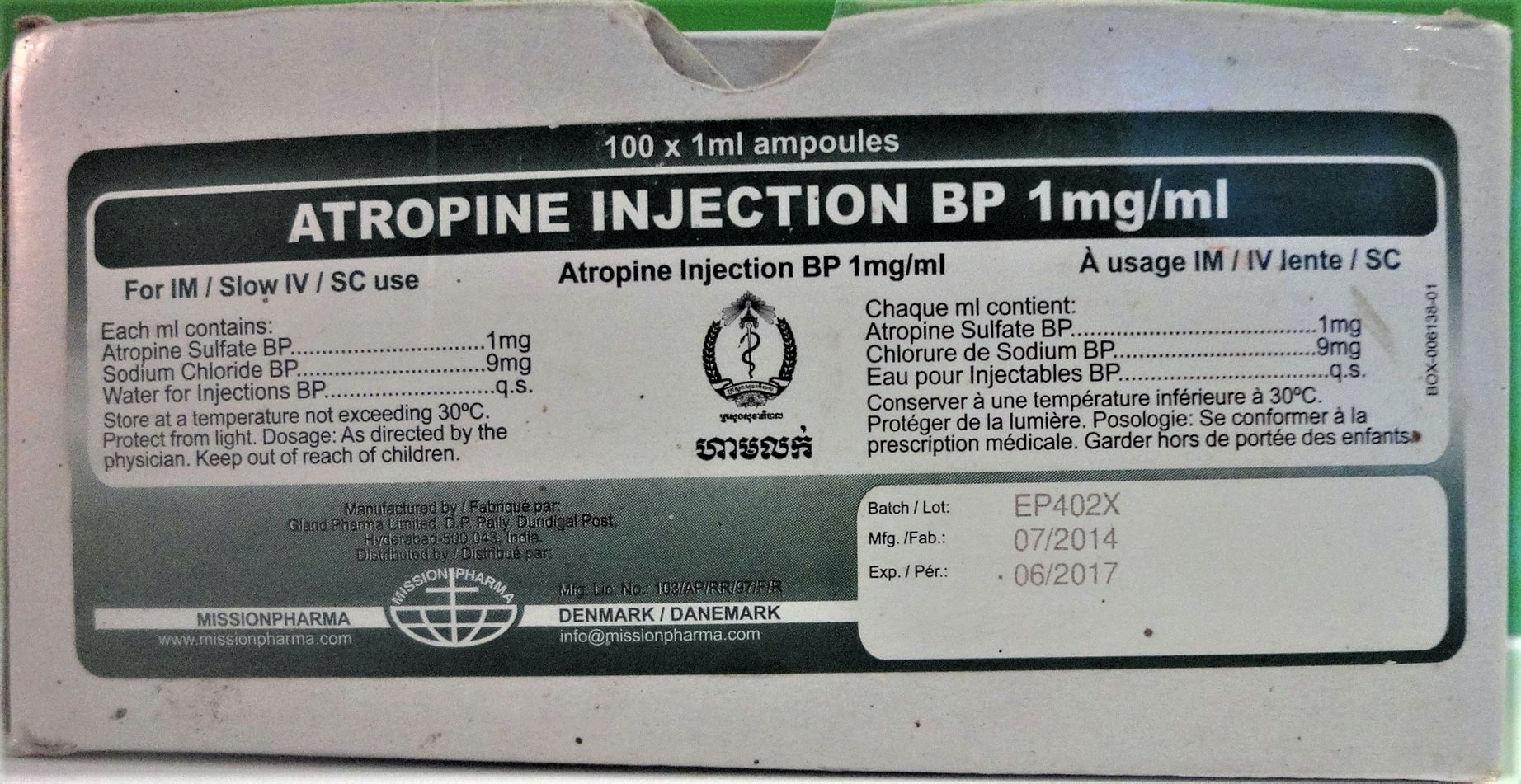ATROPINE BP Injection
ក្រុមហ៊ុនផលិតឱសថ:
Gland Pharma Ltd., India


- សារធាតុសកម្ម
- ប្រសិទ្ធិភាពព្យាបាល និង កម្រិតប្រើប្រាស់
- ហាមប្រើ
- ផលរំខាន
- អន្តរប្រតិកម្ម
- ស្ត្រីមានផ្ទៃពោះ និង ស្ត្រីបំបៅដោះកូន
- សកម្មភាពឱសថ បរិយាយប័ណ្ណឱសថ
-
សារធាតុសកម្ម
Atropine sulphate 1mg/mL
-
ប្រសិទ្ធិភាពព្យាបាល និង កម្រិតប្រើប្រាស់
Pre-anaesthetic medication to prevent salivary and bronchial secretion.
To restore muscular activity on completion of surgery when anticholinesterase agents are being used. To prevent cardiac dysrhythmias in surgery.
Spasms of the gastrointestinal and uro-genital tract if no better drugs (butyl scopolamine) are available.
As antidote in poisoning with cholinesterase inhibiting insecticides.
Administration
Pre-anaesthetic medication:
Adults: 0.3-0.6mg subcutaneously or intramuscularly 30-60 minutes before induction, or intravenously immediately before induction.
Children: under 5kg: 0.02mg/kg/dose, subcutaneously, 30-60 minutes pre-operatively.
over 5kg: 0.01-0.02mg/kg/dose, subcutaneously, 30-60 minutes pre-operatively. Minimum dose 0.1mg, maximum dose 0.4mg.
In case of cerebral malaria, the initial dose may be 10mg/kg over 8 hours by slow infusion. The maximum dosage is 25mg/kg/day, whatever the route of administration.
Restoration of muscular activity:
Administer intravenously 2-3 minutes before administration of the anti-cholinesterase agent.
Adult: 0.6-1.2mg
Child: 0.02mg/kg
Prevention of cardiac dysrhythmia:
Adult: 0.4-1.0mg intravenously.
Child: 0.01-0.03mg/kg intravenously.
Spasms of the gastrointestinal or uro-genital tract:
0.5mg intramuscularly in one dose.
Antidote:
2mg intramuscularly or intravenously every 20-30 minutes until the skin becomes flushed and dry, pupils dilate and tachycardia develops.
-
ហាមប្រើ
In patients with known hypersensitivity to the drug, obstruction of the bladder neck e.g. due to prostatic hypertrophy, reflux oesophagitis, closed angle glaucoma, myasthenia gravis (unless used to treat the adverse effects of an anti-cholinesterase agent), paralytic ileus, severe ulcerative colitis and obstructive disease of the gastrointestinal tract.
-
ផលរំខាន
Dry mouth and skin, blurred vision and skin rashes are common. Also cardiac dysrhythmias or tachycardia and confusion. Raised ocular tension especially dangerous in patients with glaucoma. Body temperature may increase and convulsions occur, especially in children, in a hot humid environment this risk is intensified.Dry mouth and skin, blurred vision and skin rashes are common. Also cardiac dysrhythmias or tachycardia and confusion. Raised ocular tension especially dangerous in patients with glaucoma. Body temperature may increase and convulsions occur, especially in children, in a hot humid environment this risk is intensified.
-
អន្តរប្រតិកម្ម
The effects of atropine may be enhanced by the concomitant administration of other drugs with anti-cholinergic activity e.g. tricyclic antidepressants, antispasmodics, anti-parkinsonian drugs, some antihistamines, phenothiazines, disopyramide and quinidine. By delaying gastric emptying, atropine may alter the absorption of other drugs.
-
ស្ត្រីមានផ្ទៃពោះ និង ស្ត្រីបំបៅដោះកូន
Pregnancy
Atropine should be used during pregnancy only when the need out-weighs any possible risk to the foetus.
Lactation
Repeated medication with atropine may reduce breast milk production, and should therefore only be used in nursing mothers if no other alternative is available.
-
សកម្មភាពឱសថ
Atropine is an antimuscarinic agent, which competitively antagonizes acetylcholine at postganglionic nerve endings, thus affecting receptors of the exocrine glands, smooth muscle, cardiac muscle and the central nervous system.
Peripheral effects include tachycardia, decreased production of saliva, sweat, bronchial, nasal, lachrymal and gastric secretions, decreased intestinal motility and inhibition of micturition.
Atropine increases sinus rate and sinoatrial and AV conduction. Usually heart rate is increased but there may be an initial bradycardia.
Atropine inhibits secretions throughout the respiratory tract and relaxes bronchial smooth muscle producing broncho dilatation.
*ព័ត៌មានឱសថត្រូវបានរៀបរៀងដោយ អ៊ីម៉ាតុគឹ មេឌីក (ខេមបូឌា) ដោយផ្អែកលើប្រភពព័ត៌មានខាងក្រោម។ សម្រាប់ព័ត៌មានលម្អិត សូមស្វែងរកនៅក្នុងក្រដាសព័ត៌មាននៃឱសថនីមួយៗ ឬ សាកសួរទៅកាន់ក្រុមហ៊ុនឱសថឬតំណាងចែកចាយនៃឱសថនីមួយៗ។
ប្រភពព័ត៌មាន៖
- ក្រដាសព័ត៌មាននៃឱសថសម្រាប់អ្នកជំនាញវេជ្ជសាស្ត្រដែលប្រើប្រាស់នៅប្រទេសជប៉ុន (Pharmaceutical and Medical Devices Agency, Pmda): https://www.pmda.go.jp
- ព័ត៌មានសង្ខេបនៃឱសថសម្រាប់អ្នកជំងឺដែលប្រើប្រាស់នៅប្រទេសជប៉ុន: http://www.rad-ar.or.jp
